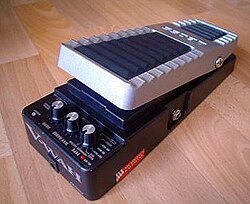Fuzz-wah
 BOSS PW-10 V-Wah combines fuzz and wah in a modern version of the classic pedal | |
| Distortion Tool | |
|---|---|
| Classification |
electronophone |
| Developed | 1968 |
| Related instruments | |
|
Fuzz, Wah-wah pedal | |
| Musicians | |
|
Jimi Hendrix, Jerry Garcia, Cliff Burton, Eric Clapton | |
A fuzz-wah pedal is a stomp box containing both a fuzzbox and a wah-wah pedal in series allowing the user to distort "wah" and the "fuzz" sounds as an aesthetic affect on an electric guitar or bass. They were developed in order to combine the iconic sounds of the more psychedelic bands of the late 1960s and 1970s.[1]
Origin
[edit | edit source]The "fuzz" concept was accidentally created in Nashville in 1961 by a malfunction in bassist Grady Martin's amplifier during a solo on a track.[2]
The Wah-wah pedal started out as a knob that was created by a British engineer and guitarist Dick Denney in hopes that the guitar would be able to imitate certain aspects of the human voice. Later on in the 1960s, guitarist Del Casher was introduced to the sound the knob could create and thought to make it into a pedal. This made it easier to use and manipulate while in the act of playing guitars, since it no longer required a hand to be used.[3]
Design
[edit | edit source]Fuzz-wah pedals normally come with at least two nobs, enabling the player to select either effect independently or together. When both are in use at once, the fuzz effect is always before the wah, allowing the wah-wah to process the richer harmonic content of the distorted sound and produce a vivid effect. The Fuzz-wah was meant to combine the two unique sounds of "fuzz" and "Wah" distortion, and make them both accessible while a guitarist was playing.[4]
Musicians
[edit | edit source]King Crimson bassist John Wetton used a fuzz-wah for his distinctive distortion sound. Jerry Garcia, guitarist of the Grateful Dead, used a Morley Fuzz Wah during that band's 1973-74 tours. Metallica's Cliff Burton used a chrome Tel-Ray Morley Power Wah Fuzz pedal for his solo sound in early days of Metallica (later switched over to Power Wah Boost in order to overdrive front end of the Mesa tube amps better for more or less identical effect). Jimi Hendrix is one of the most prevalent musicians of this period who incorporated the Fuzz and Wah wah pedal's into his sound.
References
[edit | edit source]- ↑ Hunter, Dave (2004). Guitar Effects Pedals - the Practical Handbook. Outline Press Ltd. pp. 65, 108. ISBN 0-87930-806-0. Retrieved 26 September 2015.
- ↑ Shapiro, Harry; Heatley, Michael; Mayer, Roger (2009). Jimi Hendrix Gear. MBI. p. 38. ISBN 978-0-7603-3639-7.
- ↑ Wallace, Amy (6 August 2011). "With a Flip of a Knob, He Heard the Future". New York Times. Retrieved 26 September 2015.
- ↑ "Morley Releases Cliff Burton Tribute Power Fuzz Wah Pedal". Guitar World. Newsbay Media. Retrieved 26 September 2015.
| This article relating to guitars is a stub. You can help Wikipedia by expanding it. |
